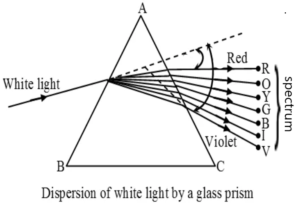
Dispersion of light is the phenomena of splitting of a beam of light into its constituents colors of light on passing through a prism. The bends of colors is called a spectrum.
For white light, the colors of the spectrum are VIBGYOR ( Violet, Indigo, Blue, Green, Yellow, Orange, Red)
Here violet color deviates through a maximum angle and the red color deviates through minimum angle.
Q> Does the prism itself create colors in some way or does it only separate the colors already present in white light?
Ans> In dispersion phenomena through a prism, when we put another similar prism but in an inverted position and let the emergent beam from the 1st prism fall on the second prism as shown in the figure. The resulting emergent beam is found to be white light.
It shows that 1st prism splits the white light and the inverted prism recombines them to give white light, which means the prism only separated its constituents colors. (This experiment is done by Isaac Newton)
CAUSE OF DISPERSION
In vacuum/ air, the speed of light is independent of wavelength because vacuum/ air is a non-dispersive medium in which all colors travel at the same speed.
But the speed of light depends on the wavelength of light when it passes through a medium( dispersive medium)
We know that the Refractive Index of a medium depends on the wavelength of light and experimentally it is found that
Where A and B are constant.
Therefore R.I () of a material is different for different colors.
And also, we know that angle of deviation depends upon R.I as( for thin prism)
As
i.e the angle of deviation is greatest for violet and least for red.
NOTE:-
1. Thick lenses could be assumed as made of many prisms, therefore thick lenses show Chromatic aberration due to the dispersion of light.
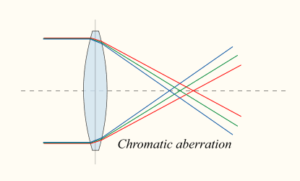
2. 
ANGULAR DISPERSION AND DISPERSIVE POWER
ANGULAR DISPERSION:-
The angular dispersion is the angle in which all colours of white light are contained. It is denoted by
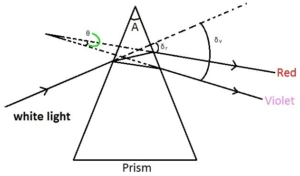
It is clear from fig. Angular dispersion()=
Let A angle of the prism
refractive index of the prism for red colour
refractive index of the prism for violet colour
i.e for small angled prism, we can write
DISPERSIVE POWER
The dispersive power of a prism is the ratio of angular dispersion to the mean deviation ( Deviation of yellow colour).
As the dispersive power increases, the angular dispersion is also increases.. It is denoted by
i.e
Note that yellow colour is taken as mean colour because the average wavelength of all seven colours is approximately the same as the wavelength of yellow colours.
For small angled prism
NOTE:-
-
- Dispersive power of a prism depends only on the nature of the material of the prism.
- When white light passes through a prism, it suffers deviation as well as dispersion. However, two prisms of different materials can be suitably combined to produce.
a. No deviation no dispersion
b. Deviation without dispersion
c. Dispersion without deviation
Q> How we can produce No deviation No dispersion, deviation without dispersion and dispersion without deviation?
a. No Deviation No Dispersion:-
Two identical prisms made of the same glass placed with their bases on opposite sides and faces touching or parallel, will neither deviate nor disperse, but will merely produce a parallel displacement of the beam.
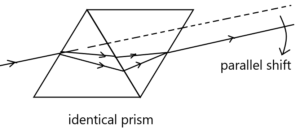
b. Deviation without dispersion:-
Deviation without dispersion is not possible for a single prism but we can combine two or more prism so that dispersion is zero. such a combination is known as an achromatic combination of prisms.
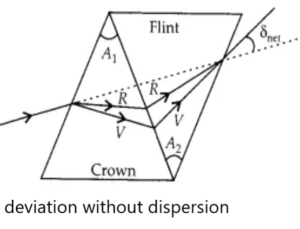
Dispersion due to the first prism
Dispersion due to the second prism
∴ Total dispersion
but in this case
This is the condition for deviation without dispersion. Here -ve sign indicates that we must place the two prisms with their prism angle in opposite direction.
c. Dispersion without deviation:-
Dispersion without deviation is not possible for a single prism but we can combine two or more prism so that dispersion is zero. such a combination is known as an achromatic combination of prisms.
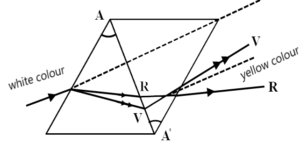
Deviation due to the first prism
Deviation due to the second prism
∴ Net deviation by both prisms is
But in this case
This is the condition for Dispersion without deviation. Here -ve sign indicates that we must place the two prisms with their prism angle in opposite direction. (Only yellow colour will not deviate, all others colours rays will deviate)
IMPORTANT QUESTIONS FOR PRACTICE
1. You are given prisms made of crown glass and flint glass with a
wide variety of angles. Suggest a combination of prisms which will
(a) deviate a pencil of white light without much dispersion,
(b) disperse (and displace) a pencil of white light without much
deviation.
